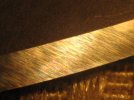Have to add to the above as I misread your post and thought you were talking about angles in general.
Is not enough for most to simply use muscle memory, though it will get the ball rolling if changing the angle.
I go by tactile feedback - what can be felt through the fingertips primarily of the non-dominant hand. I keep my fingertips right on top of the spot that is in contact with the stone. If I feel like I'm loosing reference point, I'll lower the spine so the shoulder drags on the stone, lightly, for a pass or two. Then elevate the spine till the increased feedback from the shoulder dragging lets off and keep grinding. This can be done on the fly as often as needed, especially useful when lowering the angle.
When I first start out, I'll elevate the spine and get a feel for location of the cutting edge to the rest of the mass of the knife or tool, then lower until I hit the shoulder - this is the working range and also tells me how rounded the edge is, or what the difference in degrees (roughly) exists from shoulder to apex. After this initial interview I won't elevate the spine again, and just reference to the shoulder by lowering it. This means I am working from the shoulder to the edge and the intended angle won't get any larger by floating between the two reference points. On a convex or Scandi, I go more by visual inspection of the scratch pattern initially, but always start out by thinning the face on the convex just behind the cutting edge, and on a Scandi I want to see scratch pattern start at the shoulder, and none at the edge, unless it is dead flat and then marks from shoulder to apex almost from the get-go.
Feedback will increase again as the edge is apexed and the edge is now in total contact with the abrasive, as opposed to the dull, blunted, or formerly broad edge floating just off the abrasive surface, and the abrasive is contacting a curved (or un-flat) surface. When I cannot discern any difference or increase in feedback by lowering the shoulder, and a small burr has formed, I know I've made an edge as flat as my mechanics+senses can create.
Feedback also undergoes a similar shift when kicking up to a finer hone even with a nicely flattened cutting edge - starts out less, and increases as the steel surface comes into balance with the abrasive surface.
This is the page in my manual that brings this point up


